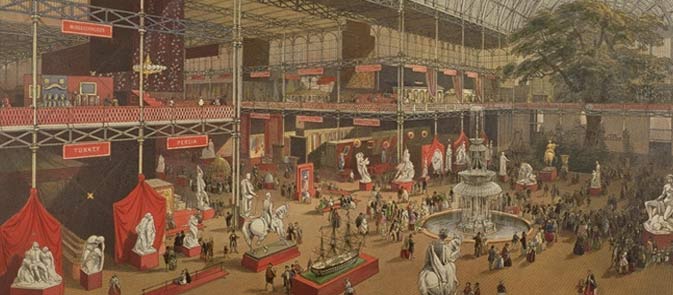
(P174) London Metropolitan Archive - LMA - article on CPC NOvember 2014

Interior view of Crystal Palace during the Great Exhibition of 1851 at Hyde Park
Brief history of the Crystal Palace campaign by Jeff Gerhardt (London Metropolitan Archive)
History
In 1851, the Crystal Palace was built in London's Hyde Park to house the 1851 Great Exhibition. It was designed by Sir Joseph Paxton and built by engineers Sir William Cubitt and Sir Charles Fox. Land was found to rebuild the palace on what was known then as Sydenham Hill. It was set in 280 acres of land which became known as Crystal Palace Park and both palace and park were primarily used for leisure activities. On 30 November 1936 the palace was completely destroyed by fire. In 1951, responsibility for the park was transferred to the London County Council, followed by the Greater London Council in 1965. In 1964, the National Sports Centre was built in the park as a sports facility and athletics park. Following the disbandment of the GLC in 1986, ownership of the park passed to the London Borough of Bromley.
The Crystal Palace Campaign's inaugural meeting was held on 28 May 1997 as a response to a planning application for a large development in Crystal Palace Park including a 20-screen multiplex. In 1998, the campaign sought a judicial review of the planning permission, but Justice Sullivan dismissed the review in July of that year. In September, the campaign appealed the decision and the High Court agreed, but the appeal was again dismissed in December 1998. In 1999, eco-warriors occupied Crystal Palace Park as part of a wider protest against the development, and Dianne Barker appealed against the multiplex due to the lack of an Environmental Impact Assessment (EIA). The same year, the campaign launched a demonstration march to Leicester Square and in 2000 organised an inquiry into the number of liquor licence applications for the development. October 2000, saw the European Commission send a letter to the UK Government stating that an EIA was required before planning consent could be given. In May 2001, the London Borough of Bromley announced that the development was cancelled due to the failure of London and Regional Properties to complete the lease in time. The campaign celebrated a victory in stopping the proposed development.
In 2002, a stakeholders group was formed and led to the formation of the Crystal Palace Dialogue Group to enable Bromley Council and community groups to work in partnership on the park’s redevelopment. In 2003, the campaign developed a public consultation survey on the park.
The Collection
The collection is comprehensive and contains administrative records, including: Steering Committee minutes, correspondence and subject files (1983-2006); papers relating to legal issues and inquiries (1995-2006); development plans (1995-9), photographs (1998-2001); printed material (1991-2004); and artefacts (1998-9).
Researchers interested in understanding how the campaign was established, administered and the challenges they faced, may like to research the administrative records in section LMA/4642/A. These papers detail the organisation of the campaign through meetings, correspondence, campaigns, promotions and lobbying of politicians. Section LMA/4642/B includes papers relating to legal aspects of the campaign to halt the development including a judicial review and the campaign’s appeal to the Court of Appeal and the House of Lords.
Researchers can also find a large amount of visual material in the form of plans (LMA/4642/C), photographs (LMA/4642/D), printed material (including newspaper cuttings) (LMA/4642/E) and artefacts (LMA/4642/F). These illustrate the results of the campaign’s work through marches, demonstrations, publicity and celebrations of the cancellation of the development in 2001.
Access
The full catalogue will be found on the LMA’s online catalogue under reference LMA/4642. Please note that many records are subject to access restrictions due to Data Protection legislation.
-----------------------------
[Ed. article published 20 October 2014, modified 5 November 2014.
Links. referenced in the article, to the Campaign website not included here for obvious reasons... but link to Crystal Palace Foundation from here.]
Top of page; Back to publications index;
26/11/14 Last updated 26/11/14